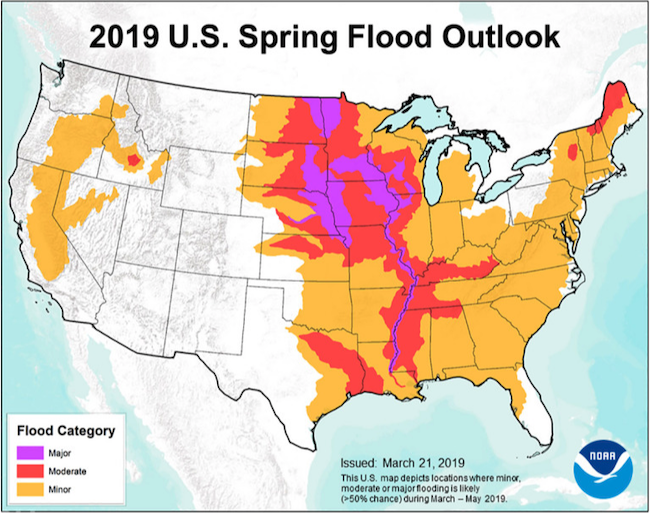No one can say that the floods which inundated Nebraska, Wisconsin, South Dakota, and Iowa after a hurricane-strength "bomb cyclone" were caused by climate change. At the same time, it would be grossly irresponsible to dismiss the role that climate change may have played in the disaster. Warmer temperatures allow the air to hold more moisture. According to a senior scientist at the National Center for Atmospheric Research in Boulder, Colorado, the 10% more moisture in the atmosphere from climate change is enough to turn a storm from a "billion-dollar disaster into a 10 to 50 billion-dollar disaster."
It's too soon to say how many billions of dollars in damage this year's flooding will cost, but it's already the worst in the history of the state of Nebraska, where 95% of the population has been affected by the storms. Even the National Weather Service's office in Omaha was inundated. So was an Air Force Base. Contaminated drinking water is a major concern -- at least six public drinking water systems went offline -- and many people rely on well water that may have been contaminated when wastewater-treatment facilities failed (Omaha has been dumping about 65 million gallons of untreated sewage daily into a creek that flows into the Missouri River).
In South Dakota, the Oglala Sioux Tribe was especially hard hit, with families trapped by floodwaters for weeks and at least four lives lost on the Pine Ridge Reservation (which is larger than the state of Delaware). Of Pine Ridge's approximately 20,000 residents, 8,000 lost access to drinking water, which is now being trucked in by the National Guard. Little wonder that the Tribe is fighting so hard to keep the Keystone XL tar sands pipeline from threatening their water supply. President Trump's response was to tweet his support for "the great people of South Dakota" and then sign an executive order to allow the Keystone pipeline to cross the border with Canada.
The scariest thing about these floods is that we don't know how much worse things will get (and some are predicting that they could get a lot worse). Check out this map from the National Oceanic and Atmospheric Administration showing which parts of the US have an elevated risk of flooding this spring.

That's two-thirds of the lower 48 states you're looking at, and about 200 million people live in those areas. In the states hit last month, levees and dams have been overwhelmed, which makes the prospect of more flooding even more dangerous.
It doesn't matter what state you call home or whether it’s considered "red" or "blue." Climate change will affect you or someone you love, and you deserve leaders who are determined to solve the problem instead of making it worse. Many states have climate action plans, for instance; South Dakota and Nebraska aren’t among them. Ironically, what Nebraska does have is a coal-fired power plant that needed to be sandbagged when the Missouri River rose. Last year, that plant produced more carbon pollution than did all of the gas-fueled cars in the state, when the situation actually demands that we replace both gas-fueled cars and coal-fired electricity.
We can't stop the rain if it comes, and we can't stop the rivers from rising. What we can do is help people affected by these disasters now, while being realistic about the future. Climate change is here. We now need to deal with both its catastrophic effects and its obvious causes. Anyone not prepared to do both shouldn’t be leading in any capacity -- at the state or the federal level.